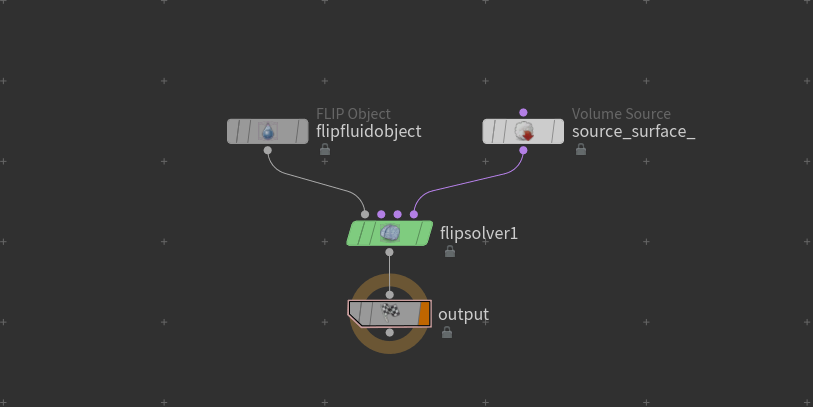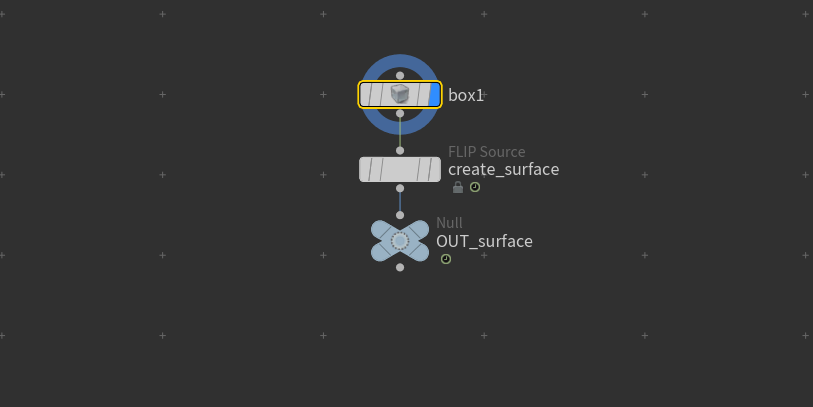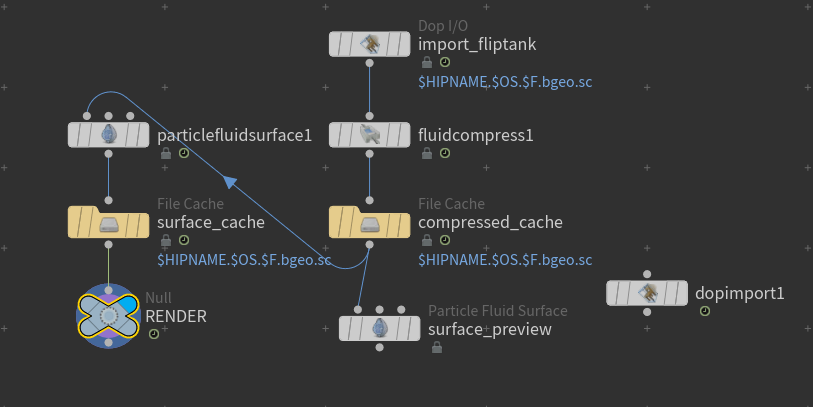Fluid Implicit Particle - Based on Navier–Stokes equations, implemented in OpenCL (can combine with vellum) hybrid solver. Fluid data is stored in the particles and only particles need to persist frame to frame Pressure projection step is done on a volume.
Basic flips
- Size sensitive: use units as meters.
- Time sensitive
| FLIP model |
|---|
| 1 Transfers the particle velocities into a volume |
| 2 Solves to maintain volume |
| 3 Push results back to the particles |
| 4 Deletes volume |

Solver
FLIP Solver
- OBJECT - mandatory
Flip ObjectSurfaceSOP/ Particles /Flip Tank (narrowband)/
- PARTICLE VELOCITY
Pop VOP/Pop Wrangle- @viscosity=x;Pop Force,Pop Curve force- (can merged)Pop Solver/Sop Solver- Access any sop (cmi)
- VOLUME VELOCITY
Gas Field VOP- Volume from sim (Illume Jeff II )Source Volume- Source as velocity field
- SOURCE
Volume Source- Initialize source (SOP link to:Flip SourceSOP) default will use op1Flip ObjectHeat Volume- Can spread temp (ie. lava cool rate)Gas Temp UpdatePop Color
Substeps
- timestep - (divide 1 frame to few)
- substep - (add steps in 1 frame) Mostly for fast moving fluid that collides with other objects and Surface tension. (no need in standard flips)
Particle Motion
Collision detection
- None
- Move Outside Collision fastest and provides the smoothest splashes, Not as accurate with fast-moving collision geometry. It is also the (only collision method that works with Volume Source based collisions).
- Particle method only works when a collision is represented by an actual DOP object. (can use direction and bounce)
Behavior
Kill Collide Friction condition + ID, Age attribs
Reseed
Fix an uneven distribution due to numerical error. (Must be on for Narrow Band)
Separation
Additional separation that prevent volume compression overwritten by velocity.
Droplets
Particle below certain density turn to droplets more likely. (tend to combine)
- After blend back to fluid: Blend / Merge / Kill
Vorticity
Chaos & White water
- Preservation rate - Decay value (how much vorticity should reman at end of the second) Retain swirling motion.
Volume Motion
Velocity Transfer (Kernel)
- Splashy FLIP - Implemented with the newer method
- Swirly APIC - is not as noisy and turb. and keep vorticity better
smoothing.
Volume Limits
- Waterline - (semi open boundaries)(above open, below close) it should be on water level.
- Use boundary layer - (adv waterline) (velocity volume - at volume boundaries) (surface volume control geo in boundary padding) if both not connected it will use warterline options. (Houdini 16 Masterclass)
Collisions
- Default velocity scale - for Volume Source is 1.5, which will cause larger splashes by default, but for moving containers this should be set to 1.
- Stick on collision - [viscosity free solutions!: ] ( simualte sth like (free slip condition) but inverse)
Viscosity
How much tend to be solid. Adhesive force which resist motion (lava). Measured in: (centi) Poise. Set value at [Flip Object] DOP.
- Slip on collision
- 0 - Collider velocity. Can’t slip - Sticky
- 1 - Fluid velocity. Slip on surface - Slide (opposite to: stick on collision)
- Viscosity by Attribute Control locally use attribute
@viscosityon points.
Density
By default, the fluid has uniform density as set on the Physical tab of the FLIP Object. @density
Air
Enforce Air Incompressibility on the FLIP Solver. This feature prevents air pockets from collapsing.
Divergence
Measure of imbalance. Scale component is using pressure field. Set up in POP VOP
Surface Tension
Tendency of liquid surfaces to shrink into the min surface area. (Require small scale but, In small scale it can be unstable > substeps) Values: 0 - 50 000
- Blurring shape.
Adhesion- menisk wklęsłyCohesion- menisk wypukły
Narrow Band
Work only with reseed.
Object
[ FLIP Object ] DOP
- Particle separation - Seed density. How far apart particles try and stay. Will change particles count.
- Particle radius scale - actual radius of every particle
- Grid scale - resolution of the volume voxels. Help preserve Volume. To low will lose informations.
Initialize:
- Surface sop -
- Particle field -
- Narrow Band - for tanks
- File - from file
Physical:
- Bounce -
- Ffd Bounce -
- Friction -
0- frictionless object - Dyamic Friction - how diferent static and dynamic object frictions are (relation)
- Temperature -
- Density -
1000kg/m3 which is default - Viscosity - in range
1-10 000 000(if viscosity by attribute in solver is checked and there is point attribute at sop viscosity will be multiplied)
[ Volume Source ] DOP
For sourcing fluids or vel fields
Initialize:
- Source FLIP - default path to
FLIP SourceSOP - Sink FLIP - sink point (size depend speed of sink)
- Pump - for vel from volume. Import vel file.
Input - path
Name source volumes - volume name
SOP
Source
[ FLIP Source ] SOP
Converts its input geometry into a volume that can be used to control simulations. i (for Volume Source DOP)

- inject liquid into a FLIP
- act as a sink in a smoke simulation.
- volume operations set behaviour (add/overide velo)
- velocity volumes source attributes - we can sample it from N or sth.
- container settings - velocity
[ Flip Tank ] SOP
Points From Volume (for source volume DOP) // source from points (change[Initial Data] input to particle field).
Oceane Source (for flip object DOP) (particles(points)+volume for: sop path and surface volume) // (change [Initial Data] input to narrow band) Fluid Tank ?
Limit Refinment iteration - can remove glitches, use only in small scale (good for visc droplets ect…) (particle fluid surface)
Collisions
Deforming Object shelf tool
Volume Source based collisions: Work only with Move Outside Collision method for particle collisions, because the Particle method only works when a collision is represented by an actual DOP object.
Move Outside Collision is the fastest collision handling method and provides the smoothest splashes, however it is not as accurate with fast-moving collision geometry.
static object with collision mode to: volume sample {DeformingGeo shelf}
- Enabling Collision Separation on the FLIP Object and setting this value to the Particle Separation or smaller will create a higher-resolution collision field
- Accurate velocities for moving collision objects are extremely important.
- {Deforming Object} shelf tool to set up deforming geometry as a FLIP collision object.
- SOP
Collision Source- interpolate deforming geometry, calculate point velocities, and create VDB. Usually used in conjunction with a Static Object DOP.
VEX
i@stopped - You can stop the particles in a flip sim with
v@v => vel
@viscosity -
Import simulation

[DOP import] SOP
Import Points
Particle Fluid Surface - limit refinement if unstable. / Change surfacing > surface output > from surface polygons to Surface VDB !!
For emitting large numbers of particles, the Volume Source DOP can be much faster than the Particle Fluid Emitter DOP.
[DOP I/O] SOP
Points + 4volumes. For further processing.
DOP Network - path to DOP Node
DOP Node - path to Flip Object
Choose volumes from preset or import custom volumes
[Fluid Compress] SOP
before cache
[Fluid Surface] SOP
to get fluid surface
Setups
- Viscosity - Lava
- Surface Tension - Deep drops, Crown Splash
- Suction - Avoidance
- Divergence -
Micro
depend on velo, scale, grid size
- On solver:
- Sub steps up!! up 5+
- On Surface tension
- Velocity transfer: Splashy » Swirly
- In self they reduce gravity. Gravity reduced in Drip and crown to have small scale
Crown Splash
- Flip tank with boundary layer
- Surface tension: 48 more motion / 200 high value less motion for
- Grid scale // fat 2 / thin 1.5 (grid to create surface and measure curvature )
- you can blur curvature
Droplet
- Surface tension: high 48000 to prevent fall down
Suction Fluid
Extension of surface tension.
- Pop wrangle: op2 antigravity (oppose gravity around object), inside have no gravity.
- Gas field wrangle: op3 suction force. strength + gradient on distance sometimes you need to keyframe it
- collision source on geometry (velocity, volume out) + interior exterior distance for gradient strength and ramp in world units meters (outside ) .
- ! remember voxel size on collision source volume cretion. !!!!!!!!!
- narrow band needed as well !!!!!
Values to animate:
outside distance: big: good to pull from ground, smaller give better shape.
strength: 120 000 anim > 480 000 keep inside
Multiple solvers
Floating RDB
DOP>flipsolver>Volume Motion>solver change Feedback Scale from 0 to 1.
https://vimeo.com/116176349#at=158
https://youtu.be/JzxXjHgkIIc
Merge: rigidbody solver + flip solver
Check density of object (mass)
Bullet solver with rdb object is working as well
Pyro > Fluid
https://vimeo.com/157944287
Sim Pyro > Import > Points from volume
Flip Object > change sop path to points
Cration frame spec sim frame check
Pyro > Fluid
https://vimeo.com/296410457
…
Fluid Follow Curve
https://forums.odforce.net/topic/31596-fluid-follow-curve/
Mix Colors
https://youtu.be/DWxcfZMsZW8
www.sidefx.com/docs/houdini/nodes/dop/flipsolver.html
www.danenglesson.com/images/portfolio/FLIP/rapport.pdf
## Velocity1
you can create `velocity field` > `source volume`
## Populate containers
Can work with flips
`Pump from ` - create volume velocity (like)
http://igorfx.com/hou_adaptive_flip/
https://www.youtube.com/watch?v=3oikshVefJ4
Also use for collision in flips flips (FLIP Fluids https://vimeo.com/116176349)